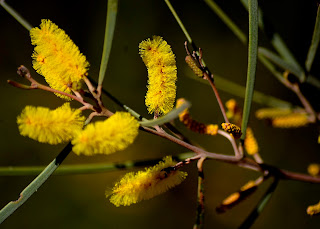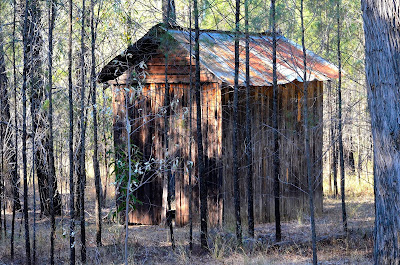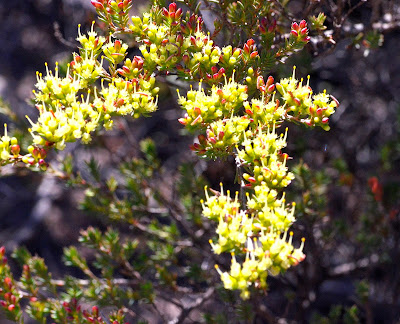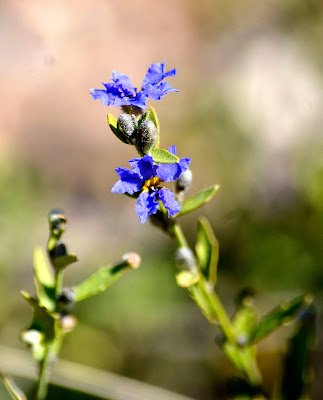Members of the Gympie and District Field Naturalists' Club and their friends travelled to the southern slopes of the Great Dividing Range, north of Miles and Chinchilla on the Western Darling Downs. The purpose of this trip was to search for the wildflowers known to be growing in the sandstone gullies and on the rocky ridges. The weather was magnificent, the guiding party provided by the Chinchilla Field Naturalists was informative, and the company congenial resulting in an ideal mix for a great week.
Members were guide through the Barakula State Forest, Binkey State Forest, Gurulmundi State Forest, and the Waaje area. The Leichhardt Highway dissects these areas. The days were very full driving to and walking in the different countryside. The nights spent around the camp fire discussing what we had seen were an enjoyable finish to the days activities.
 |
| Acacia barakulensis (Wajja wattle) ----- shrub to 2 metres. |
 |
Acacia amblygona (fan wattle) ----- low spreading
habit ----- sharp point on end of leaves. |
 |
Acacia buxifolia (box-leaf wattle) ---- shrub to 4 metres ---
bright yellow flowers in bracelets. |
 |
| Acacia julifera . subsp. julifera |
Wattles in the Midwest - The varieties of these Australian beauties were flowering wherever the group ventured. However, arriving at L.Tree Creek ( named after Leichhardt's tree, the one of many he blazed L into the bark to help with identification on the return trip), the different golden, yellows were overwhelming. These are some of the photographs of the different wattles one can see and have fun identifying.
The plant lists, kindly given to us by our hosts, list fifty (50) different names to align your photos to.
 |
| Acacia spectabilis (glory wattle) |
 |
| Acacia caroleae (Carol's wattle) |
 |
| Acacia juncifolia (rush-leaf wattle) ----- shrub to 2 metres |
 |
| Homalocalyx poyandrus ----- photo on the left |
 |
|
 |
| Tin Hut - Blinkey State Forest - This is the last standing structure of the property of H.Mason . The State forest was gazetted after the property was purchased in 1950. The land was first settled during 1800's and the owners grazed sheep. The remains of other structures believed to be Pig-sty, Blacksmith workshop , large shed for wagons, sulkies and sheep shearing area. An old abandoned wool wagon has been taken to the local museum. The 'Tin Hut' has Cypress walls, undoubtedly, the reason it is still there, has not been attached by Termites. The property is on Tin Hut Creek, and evidence of many wells around the property exist, the continual looking for water a constant chore. When the owners took up the land it was different to what we viewed on the day. The Black Cypress are abundant, however records state the owners state they have taken up a holding in a well grassed open area. It is believed the area was kept open by burning by the Aboriginal people of the area. When the sheep arrived they continued with the culling of the small Cypress growth. The area is now left to grow naturally. |
 |
| Grevillea longistyla ---- occurs naturally in open forest woodlands on the sandstone ridges of the Great Dividing Range. |
 |
| Micromyrtus sessilis ----- curly-bark micromyrtus --- small white to pink flowers for a great display. ----- note the woolly bark. |
 |
| Micromyrtus carinta (yellow ) and Micromyrtus patula (white) ------ Gurulmundi Heath-myrtle ----- inhabits the tops of ridges on yellow or red sands. ----- a member looking for more flowers. |
 |
| This water storage hole was in the lower section of the sandstone plateau ------ believed to be a water storage hole used by previous generations ----- filled by soil over the years and now supporting a tree and grass. |
 |
| Homoranthus melanostictus -----mouse bush ----- member of the Myrtaceae family ----- This one has grey-green foliage, another variety decumbens, has purple foliage. These plants were admired by all members, only grows in this section of Australia. |
 |
| Dampiera adpressa ------ small shrub ----- named for William Dampier |
 |
| Hakea purpurea (needle-wood) --- erect shrub 1 to 3 meters in height. ---- flower followed by woody seed pods 40mm long by 15mm wide ---- The pods don't shed their seeds until stimulated by bushfire. |







